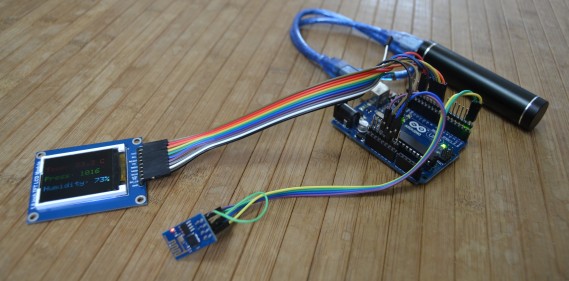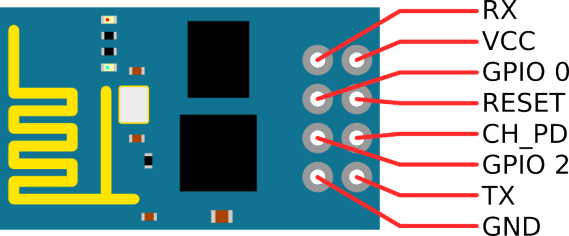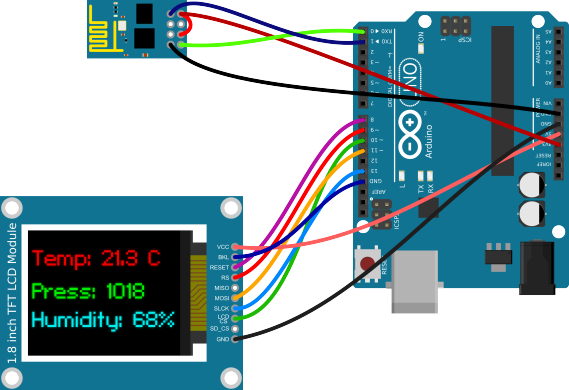
This is my first attempt to receive data with an Arduino and the ESP8266 WiFi-Module. This program is based on the example by Seedstudio, and displays weather data on a small TFT display.
The Modul

I bought this module at Electrodragon. This Version has two LEDs, one for Power and another one which is connected to the TX-Pin. It runs at 3.3 Volt and the serial port is set to a data rate of 115200 baud. The CH_PD-Pin has to be high. After a reset, the module sends the following data:
1
2
3
4
5
6
7
8
9
10
11
12
13
14
15
16
17
18
19
| AT+RSTOK ets Jan 8 2013,rst cause:4, boot mode:(3,6)wdt resetload 0x40100000, len 24236, room 16tail 12chksum 0xb7ho 0 tail 12 room 4load 0x3ffe8000, len 3008, room 12tail 4chksum 0x2cload 0x3ffe8bc0, len 4816, room 4tail 12chksum 0x46csum 0x46ready |
Wiring
The wiring is quite simple. The wifi-module needs just two wires for power and two for the serial interface. As a display i used a 1.8″ (45.72 mm) TFT-display that is connected via SPI.

| Arduino | ESP8266 Module | Display Module |
|---|---|---|
| 3.3V | VCC & CH_PD | |
| 5V | VCC | |
| GND | GND | GND & BKL |
| 0 (RX) | TX | |
| 1 (TX) | RX | |
| 8 | RESET | |
| 9 | RS | |
| 10 | LCD CS | |
| 11 | MOSI | |
| 13 | SLCK |
The Program
I changed the source code from Seedstudio a little bit, because at 115200 baud the 64 Byte uart-buffer from the Arduino fills up very fast. But overall the program is really simple.
1
2
3
4
5
6
7
8
9
10
11
12
13
14
15
16
17
18
19
20
21
22
23
24
25
26
27
28
29
30
31
32
33
34
35
36
37
38
39
40
41
42
43
44
45
46
47
48
49
50
51
52
53
54
55
56
57
58
59
60
61
62
63
64
65
66
67
68
69
70
71
72
73
74
75
76
77
78
79
80
81
82
83
84
85
86
87
88
89
90
91
92
93
94
95
96
97
98
99
100
101
102
103
104
105
106
107
108
109
110
111
112
113
114
115
116
117
118
119
120
121
122
123
124
125
126
127
128
129
130
131
132
133
134
135
136
137
138
139
140
141
142
143
144
145
146
147
148
149
150
151
152
153
| #include <SoftwareSerial.h>#include <JsonParser.h>#define cs 10 // Pins for the display#define dc 9#define rst 8#include <Adafruit_GFX.h> // Core graphics library#include <Adafruit_ST7735.h> // Hardware-specific library#include <SPI.h>Adafruit_ST7735 tft = Adafruit_ST7735(cs, dc, rst);using namespace ArduinoJson::Parser;#define SSID "<ssid>" // insert your SSID#define PASS "<password>" // insert your password#define LOCATIONID "2925533" // location id#define DST_IP "188.226.224.148" //api.openweathermap.orgSoftwareSerial dbgSerial(2, 3); // RX, TX for debuggingJsonParser<32> parser;void setup(){ Serial.begin(115200); Serial.setTimeout(5000); dbgSerial.begin(9600); // for debuging dbgSerial.println("Init"); tft.initR(INITR_BLACKTAB); tft.setRotation(1); tft.fillScreen(ST7735_BLACK); tft.setCursor(2, 2); tft.setTextColor(ST7735_WHITE); Serial.println("AT+RST"); // restet and test if module is redy delay(1000); if(Serial.find("ready")) { dbgSerial.println("WiFi - Module is ready"); tft.println("WiFi - Module is ready"); }else{ dbgSerial.println("Module dosn't respond."); tft.println("Module dosn't respond."); tft.println("Please reset."); while(1); } delay(1000); // try to connect to wifi boolean connected=false; for(int i=0;i<5;i++){ if(connectWiFi()){ connected = true; tft.println("Connected to WiFi..."); break; } } if (!connected){ tft.println("Coudn't connect to WiFi."); while(1); } delay(5000); Serial.println("AT+CIPMUX=0"); // set to single connection mode}void loop(){ String cmd = "AT+CIPSTART=\"TCP\",\""; cmd += DST_IP; cmd += "\",80"; Serial.println(cmd); dbgSerial.println(cmd); if(Serial.find("Error")) return; cmd = "GET /data/2.5/weather?id="; cmd += LOCATIONID; cmd += " HTTP/1.0\r\nHost: api.openweathermap.org\r\n\r\n"; Serial.print("AT+CIPSEND="); Serial.println(cmd.length()); if(Serial.find(">")){ dbgSerial.print(">"); }else{ Serial.println("AT+CIPCLOSE"); dbgSerial.println("connection timeout"); tft.fillScreen(ST7735_BLACK); tft.setCursor(2, 2); tft.setTextColor(ST7735_WHITE); tft.println("connection timeout"); delay(1000); return; } Serial.print(cmd); unsigned int i = 0; //timeout counter int n = 1; // char counter char json[100]="{"; while (!Serial.find("\"main\":{")){} // find the part we are interested in. while (i<60000) { if(Serial.available()) { char c = Serial.read(); json[n]=c; if(c=='}') break; n++; i=0; } i++; } dbgSerial.println(json); JsonObject root = parser.parse(json); double temp = root["temp"]; double pressure = root["pressure"]; double humidity = root["humidity"]; temp -= 273.15; // from kelvin to degree celsius tft.fillScreen(ST7735_BLACK); tft.setCursor(2, 25); tft.setTextColor(ST7735_BLUE); tft.setTextSize(2); tft.print("Temp: "); tft.print((int)temp); tft.print("."); tft.print((int)((temp-(int)temp)*10)); tft.println(" C"); tft.setCursor(2, 55); tft.setTextColor(ST7735_GREEN); tft.setTextSize(2); tft.print("Press: "); tft.print((int)pressure); tft.setCursor(2, 85); tft.setTextColor(ST7735_YELLOW); tft.setTextSize(2); tft.print("Humidity: "); tft.print((int)humidity); tft.println("%"); dbgSerial.println(temp); dbgSerial.println(pressure); dbgSerial.println(humidity); dbgSerial.println("===="); delay(600000);}boolean connectWiFi(){ Serial.println("AT+CWMODE=1"); String cmd="AT+CWJAP=\""; cmd+=SSID; cmd+="\",\""; cmd+=PASS; cmd+="\""; dbgSerial.println(cmd); Serial.println(cmd); delay(2000); if(Serial.find("OK")){ dbgSerial.println("OK, Connected to WiFi."); return true; }else{ dbgSerial.println("Can not connect to the WiFi."); return false; }} |
Conclusion
The program is quite simple and could be extended with more features like a weather forecast. If you have any comments about the source code leave it down below. I hope i don’t have to many spelling mistakes in my first English post 
Update: There was a bug in the code, which was found by Jody Roth. This is now fixed.





Đăng nhận xét